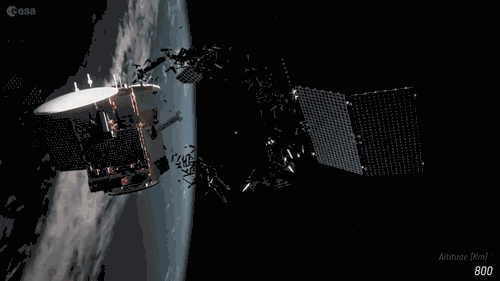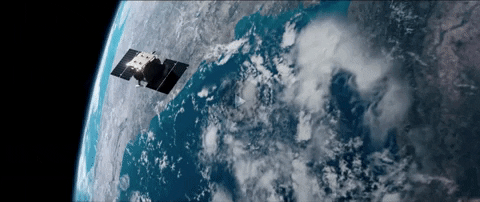Making space more sustainable, one rating at a time
Space is vast, but with humankind sending more and more spacecraft into orbit each year, it is starting to get uncomfortably crowded. The Space Sustainability Rating is a new non-profit association helping to shine a light on behaviours in space, one rating at a time.
Last year humanity broke an impressive record: worldwide, space operators successfully launched a whopping 180 rockets into space. A big chunk of these sent up objects to orbit our planet in a low-Earth orbit, what we call LEO. These objects stay at an altitude of less than 2000 km and help us with tasks like Earth observation and telecommunications. But because lower orbits are so useful, they can get quite crowded.
ESA estimates that currently around 20 000 objects are drifting through these lower orbits. Consequently, close encounters between objects, also known as 'conjunctions', are at an all-time high, meaning satellites and other spacecraft or debris fragments are increasingly at risk of colliding with each other.

With these numbers in mind, in 2016, the World Economic Forum launched the SSR initiative and was joined by ESA and other partners to form the SSR consortium, with the acronym standing for Space Sustainability Rating. The SSR now stands alone as a non-profit association, and has been working on rating space missions according to their sustainability since June 2022.
From bronze to platinum: the rating
"The SSR is the most mature rating assessment for space sustainability in the space sector. We can perform ratings for companies who want to assess, design and operate more sustainable and responsible missions," says Emmanuelle David, Executive Director at the EPFL Space Center, where the non-profit is based.
To rate a mission, the operator in charge of it voluntarily reaches out to the SSR to start the process. The SSR team collects relevant information regarding different aspects of the mission's sustainability efforts and then sends these data to their computation partners. Afterwards, the non-profit gathers it all and computes the rating. Ratings are split into four labels: bronze, silver, gold and platinum, with platinum being the most sustainable stamp. The rating also includes bonus stars depending on the strategies a space operator is following to 'go above and beyond' the baseline rating.
But how exactly does one measure whether a mission is sustainable or not? The SSR has the answer - as a matter of fact, it has six answers.
The team collects information on six modules: mission index; detectability, identification and trackability; collision avoidance capabilities; data sharing; design and operations standards and external services.
One module at a time
"These modules are mostly focused on the space debris aspect and sustainability in space. We also want to extend at some point to sustainability on Earth, through life cycle assessment, for instance, but for now, this is the first iteration," says Adrien Saada, the SSR’s operation officer.
'Mission index', the first module, which weights most heavily when calculating the rating, quantifies how harmful a spacecraft can be to its surrounding environment. To assess this, SSR's partners use a model to compute how probable it is that a mission will collide with other objects while measuring how severe that collision might be.
"The module takes into account the number of spacecraft, their mass, cross-sectional area and orbital parameters of the spacecraft to compute a risk expressed as the probability of collision multiplied by its potential severity. This risk metric also considers operational parameters, such as the operational lifetime, if there's a collision avoidance strategy, and the efficiency of the collision avoidance strategy," says Adrien.
Besides collision avoidance manoeuvres, the team looks at the risk linked to other strategies, such as what a spacecraft operator will do once the mission has fulfilled its duty. “The end-of-life strategy and post mission disposal plays a huge role in this mission index computation,” he adds.
The remaining five modules assess other aspects key to space sustainability. Under the 'detectability, identification and trackability' module, the rating sees if operators on Earth can detect, identify and track a spacecraft from the ground (after all, you can only avoid collisions if you know where the spacecraft are).
The 'data sharing' module measures whether space operators share relevant mission-related information with their peers and stakeholders. This is crucial to keeping spacecraft safe at all times. "Today, when we talk about conjunction alerts, often it's a phone call, or it's an email to actually resolve the situation. If you don't know who this person is and how to contact them, then it makes the process less efficient," adds Adrien.
The SSR also assesses whether a mission's sustainability approach aligns itself with international efforts. While each space agency has its own way of flying missions, institutions like the United Nations have published international documents to standardise everyone's approach to space sustainability. The fifth module of the SSR looks for ways of enforcing these guidelines in every mission. "Basically, the goal of the SSR is not to replace the space debris mitigation guidelines [of each operator] or any other guidelines for sustainability, but rather to enforce them," Adrien adds.
The SSR looks at other sets of information to provide ratings to missions at any stage. "We can rate missions that are at any stage of development. Whether they're in preliminary design or already in orbit, we can rate them," Adrien says. However, ideally, the earlier the rating, the better. "If you want to build a sustainable spacecraft, then you need to think about it from the very early phases of development. It's not only about the design but also about how the spacecraft is operated," he adds.
Currently, ESA is working on mitigation strategies within its Clean Space initiative and Zero Debris Approach. While the problem of space debris is worrying, to Adrien and Emmanuelle, each initiative counts. "I believe that there's time to react. I think that regulations might take a bit long, which is why we have this rating, so that we can motivate operators to regulate themselves now," Adrien concludes.






